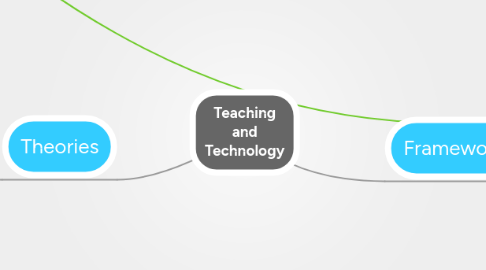
1. Theories
1.1. Learning Theories
1.1.1. Connectivism
1.1.1.1. Learning is the process of developing a network
1.1.1.1.1. Connecting "nodes" of information
1.1.1.1.2. Ability to visualize connections
1.1.1.1.3. Nurturing connections
1.1.1.2. Appropriate for the digital age
1.1.1.3. Knowledge revolves around the diversity of opinions
1.1.1.4. Learners need to know how to seek out the right kind of information
1.1.1.5. Learners receive up-to-date information so their knowledge-base is constantly growing
1.1.1.5.1. RSS Feeds
1.1.1.5.2. Following people/organizations on Twitter
1.1.1.6. Teacher is more of a facilitator than a lecturer
1.1.1.7. Teachers enable students to develop strong research skills and guide them towards knowing how to make valuable connections
1.1.2. Cognitive Load
1.1.2.1. Everyone has a working memory
1.1.2.1.1. Short term, small capacity
1.1.2.1.2. Visual scratchpad
1.1.2.1.3. Phonetic scratchpad
1.1.2.2. Everyone has a long-term memory
1.1.2.2.1. Large capacity
1.1.2.3. Learning is the process of transferring information from our working memory to our long-term memory
1.1.2.3.1. Schema: connections between previous knowledge (in long-term memory) and new information (from working memory)
1.1.2.4. An overstimulated/overloaded working memory diminishes the learner's capacity to build schema
1.1.2.4.1. The design and organization of learning tools is important
1.1.2.4.2. Teachers should try to maintain a balanced concentration of new information to avoid overload
1.1.3. Constructivism
1.1.3.1. Learning is the process of constructing knowledge based on personal experiences and interactions
1.1.3.2. Learners actively engage in their own learning
1.1.3.3. Constructionism
1.1.3.3.1. Learning is most effective when learners physically construct models and objects
1.1.3.4. Teachers encourage students to construct their own knowledge; they don't simply lecture them on facts
1.1.3.5. Teachers can provide problem-based and project-based learning activities
1.1.3.5.1. Lets students control their learning
1.1.3.5.2. Emphasizes real-world knowledge
1.2. Technology Theories
1.2.1. Media Ecology
1.2.1.1. Understands media as environments
1.2.1.2. Technology shapes society
1.2.1.3. The method of delivering a message is as, if not more, important than its content
1.2.1.3.1. "The medium is the message" - Marshall McLuhan (1964)
1.2.1.4. Teachers should be aware that their students learning of information is a function of how (i.e., with what medium) they present that information
1.2.1.5. Different mediums/technologies will be appropriate for different lessons
1.2.2. SCOT
1.2.2.1. Social Construction of Technology
1.2.2.2. Technology is influenced by human actions and interactions (not vice versa)
1.2.2.3. Technological developments are constructed by social factors
1.2.2.4. Can be used to assess the success or failure of a technology
1.2.2.5. Teachers can evaluate the effectiveness and appropriateness of an educational technology according to the social environment in their classrooms
2. Frameworks
2.1. TPACK
2.1.1. Technology, Pedagogy, and Content Knowledge
2.1.2. Technology Knowledge
2.1.2.1. How to use technology (proficiently and effectively as a means to an end)
2.1.2.2. What technology is available
2.1.2.3. Understanding theories of technology
2.1.3. Pedagogy Knowledge
2.1.3.1. How to create lesson plans
2.1.3.2. How to manage a classroom
2.1.3.3. Understanding learning theories
2.1.3.4. Working with children in an academic environment
2.1.4. Content Knowledge
2.1.4.1. What do teach (i.e., curriculum)
2.1.4.2. Understanding of subject material
2.1.5. Interactions between the three domains of knowledge should be balanced and strong
2.1.5.1. When all three come together effectively, TPACK is achieved
2.1.6. Ideal TPACK from http://tpack.org/
2.2. Philosophy of Teachnology
2.2.1. A teacher's philosophy of how he/she uses technology in the classroom
2.2.2. An extension of a teacher's Philosophy of Teaching
2.2.3. Should be personal and develop over time
2.2.4. Can include how the teacher unites technology, pedagogy, and content knowledge
2.2.5. Examples
2.2.5.1. http://www.caitrb.com/teachnology-statement.html
2.2.5.2. http://www.slideshare.net/AlexanderMSU/phill-alexander-teachnology-statement-powerpoint-version#AL881
2.2.5.3. http://youtu.be/dx-qR2aVMNM
